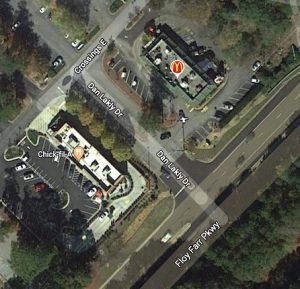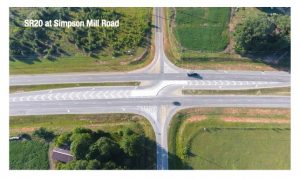Over many years, customers of McDonald’s and Chick-fil-A in central Peachtree City have been used to making left turns from the fast-food restaurants onto Ga. Highway 54 northbound. That’s about to change.

Acting without discussion Feb. 6 on a consent agenda item, the Peachtree City Council approved spending nearly $72,000 to fundamentally change how motorists access Hwy. 54 from Dan Lakly Drive in the center of town and the crossing at Governor’s Square about a mile northeast of that spot.
Both those crossings have no traffic signal, but soon each will feature a “reduced conflict U-turn” — also known as an R-Cut — as a way to make left turns onto Hwy. 54.
From the Georgia DOT explanation of “What is an RCUT and how does it work”:
“An RCUT is an intersection design that reduces crashes by changing how minor road traffic crosses or turns left at a major road, reducing the potential conflict with other vehicles.
“At an RCUT, minor road traffic must turn right. Left turn and through movements from the minor road are accomplished through the use of a downstream U-turn. All movements (left, though, and right) are allowed from the major road.
“For example, drivers who would turn left from the minor road at a conventional intersection must now turn right instead, then make a U-turn at the designated location.
“Drivers who would cross the main highway once reaching a conventional intersection must now turn right first, make a U-turn at the designated location and then turn right onto the adjoining side street at the RCUT intersection.”

The pluses for the new design, says the DOT, are as follows:
• Reduce the number and severity of vehicle-to-vehicle conflict points by approximately 50 percent in comparison to conventional intersections.
• Supports a community’s pedestrian and bicycle goals as provisions for walking and biking can shape the RCUT design.
• Reduces delay and congestion for through traffic on major road.
• Reduces queuing on the minor road because vehicles do not have to wait for gaps in traffic traveling in two directions.
• Installing RCUT intersections is accomplished in much shorter timeframes than traditional intersections that require more extensive roadwork, greatly reducing cost.
• Provides local access to a main highway while delivering safer, more efficient travel.
• Provides access to local businesses and commercial areas because the U-turns accommodate all movements.







Safety is out of discussion, but, “” $ 72,000.00 “” !!! … mmmmm… you can build up a small 3 bed 2 bath house with that money … just for two boulevards … and it was approved out of discussion, that means not 2 or 3 estimates from different companies, evaluate traffic impact, etc, etc… again, $ 72,000.00 … now I know why our taxes always gets raised and never it is enough … $ 72,000.00, I repeat this because I’m sure, something is wrong in here, $12,000.00 I can believe, $20 k’s I will say too much but well… but …
I’m pleased to hear of this decision. I know many will complain, but it will improve safety at those locations.
However, I’m a little surprised the same decision has not yet been made regarding Petrol Point.
These intersections really do save TIME, MONEY AND LIVES – in reverse order of importance. So many people stubbornly use the left turn option and eventually take a chance trying to beat an oncoming car. Drivers of cars stacks behind the left-hand loser get frustrated and they too lose time and judgement. Of course some observe, think and when it is their turn go right and make a u-turn. Even without these lanes, a u-turn is a safer and more efficient option, but you can’t explain that to some people, so blocking off that option saves us from the stubborn holdouts and makes things safer for us all.
This is a good time to point out that most of the dangerous left turns – like the one at McDonald’s, Petrol Point and the very worst by the bank at Westpark have alternative routes to get to a traffic light that will allow a protected left-hand turn onto the highway. Might take an extra minute or two. That’s a lot less time that you spend at even a non-fatal accident. And after the accident you come home and your father or husband says “I told you never turn left on a highway if there’s another way” That takes extra time as well after which you always remember the accident and lecture and start using the alternate. I am speaking from personal experience.
The state doesn’t address this. When they build a highway the object is to keep traffic moving – no lights, stop signs or calming devices. I remember going to some hearings at city hall about Petrol Point after 2 people were killed and many more injured in left-turn accidents. Even then the state fought the traffic light but did get the median cut blocked. One of those dead people was my former partner’s secretary rushing home after work to prepare for her daughter’s birthday. No speed or impaired driving at all – she pulled out for a left turn and got hit by some guy driving the speed limit. Whose fault? Her’s? His? City? State?
Well said, I always use a light for a left when possible. There is a way out of this center that fully allows that.
So, this is what they do in pre-school? Draw traffic pictures.